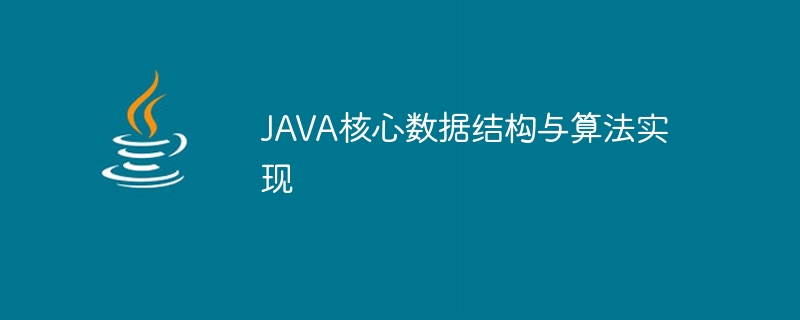JAVA核心資料結構與演算法實現
java
資料結構
演算法

由於文章篇幅有限,我將提供一些關鍵資料結構和演算法的實作範例。首先介紹幾個核心資料結構和演算法,然後給出對應的Java程式碼範例。
-
陣列
- 實作一個動態擴充的陣列
- 實作陣列的增刪改查運算
public class DynamicArray<T> {
private Object[] array;
private int size;
private int capacity;
public DynamicArray() {
capacity = 10;
array = new Object[capacity];
size = 0;
}
public void add(T element) {
if (size == capacity) {
capacity *= 2;
Object[] newArray = new Object[capacity];
System.arraycopy(array, 0, newArray, 0, size);
array = newArray;
}
array[size++] = element;
}
public T get(int index) {
if (index < 0 || index >= size) throw new IndexOutOfBoundsException();
return (T) array[index];
}
public void remove(int index) {
if (index < 0 || index >= size) throw new IndexOutOfBoundsException();
for (int i = index; i < size - 1; i++) {
array[i] = array[i + 1];
}
size--;
}
}登入後複製
鍊錶
- 實作一個單鍊錶
- 實作鍊錶的增刪改查操作
public class ListNode {
int val;
ListNode next;
ListNode(int val) {
this.val = val;
}
}
public class LinkedList {
private ListNode head;
public void addAtHead(int val) {
ListNode newHead = new ListNode(val);
newHead.next = head;
head = newHead;
}
public void addAtTail(int val) {
if (head == null) {
head = new ListNode(val);
} else {
ListNode current = head;
while (current.next != null) {
current = current.next;
}
current.next = new ListNode(val);
}
}
public void deleteAtIndex(int index) {
if (index == 0) {
head = head.next;
return;
}
int count = 0;
ListNode current = head;
ListNode prev = null;
while (current != null && count < index) {
prev = current;
current = current.next;
count++;
}
if (current != null) {
prev.next = current.next;
}
}
public ListNode get(int index) {
ListNode current = head;
int count = 0;
while (current != null && count < index) {
current = current.next;
count++;
}
return current;
}
}登入後複製
堆疊
- 實作一個基於陣列的堆疊
- 實作堆疊的入堆疊、出棧等操作
public class ArrayStack {
private int[] array;
private int top;
private int capacity;
public ArrayStack(int capacity) {
this.capacity = capacity;
array = new int[capacity];
top = -1;
}
public void push(int value) {
if (top == capacity - 1) throw new IllegalStateException("Stack is full");
array[++top] = value;
}
public int pop() {
if (top == -1) throw new IllegalStateException("Stack is empty");
return array[top--];
}
public int peek() {
if (top == -1) throw new IllegalStateException("Stack is empty");
return array[top];
}
public boolean isEmpty() {
return top == -1;
}
}登入後複製
隊列
- 實作一個基於陣列的佇列
- 實作佇列的入隊、出隊等運算
public class ArrayQueue {
private int[] array;
private int front;
private int rear;
private int capacity;
public ArrayQueue(int capacity) {
this.capacity = capacity;
array = new int[capacity];
front = 0;
rear = -1;
}
public void enqueue(int value) {
if (rear == capacity - 1) throw new IllegalStateException("Queue is full");
array[++rear] = value;
}
public int dequeue() {
if (isEmpty()) throw new IllegalStateException("Queue is empty");
int value = array[front];
front++;
return value;
}
public int peek() {
if (isEmpty()) throw new IllegalStateException("Queue is empty");
return array[front];
}
public boolean isEmpty() {
return front > rear;
}
}登入後複製
排序演算法
- #實作冒泡排序、插入排序、選擇排序、快速排序等演算法
public class Sort {
public static void bubbleSort(int[] array) {
int length = array.length;
for (int i = 0; i < length - 1; i++) {
for (int j = 0; j < length - 1 - i; j++) {
if (array[j] > array[j + 1]) {
int temp = array[j];
array[j] = array[j + 1];
array[j + 1] = temp;
}
}
}
}
public static void insertionSort(int[] array) {
for (int i = 1; i < array.length; i++) {
int current = array[i];
int j = i - 1;
while (j >= 0 && array[j] > current) {
array[j + 1] = array[j];
j--;
}
array[j + 1] = current;
}
}
public static void selectionSort(int[] array) {
for (int i = 0; i < array.length - 1; i++) {
int minIndex = i;
for (int j = i + 1; j < array.length; j++) {
if (array[j] < array[minIndex]) {
minIndex = j;
}
}
int temp = array[i];
array[i] = array[minIndex];
array[minIndex] = temp;
}
}
public static void quickSort(int[] array, int low, int high) {
if (low < high) {
int mid = partition(array, low, high);
quickSort(array, low, mid - 1);
quickSort(array, mid + 1, high);
}
}
private static int partition(int[] array, int low, int high) {
int pivot = array[high];
int i = low - 1;
for (int j = low; j < high; j++) {
if (array[j] < pivot) {
i++;
int temp = array[i];
array[i] = array[j];
array[j] = temp;
}
}
int temp = array[i + 1];
array[i + 1] = array[high];
array[high] = temp;
return i + 1;
}
}登入後複製
以上是一些核心的資料結構和演算法的Java實作範例,希望能對你有幫助。
以上是JAVA核心資料結構與演算法實現的詳細內容。更多資訊請關注PHP中文網其他相關文章!
本網站聲明
本文內容由網友自願投稿,版權歸原作者所有。本站不承擔相應的法律責任。如發現涉嫌抄襲或侵權的內容,請聯絡admin@php.cn

熱AI工具

Undresser.AI Undress
人工智慧驅動的應用程序,用於創建逼真的裸體照片

AI Clothes Remover
用於從照片中去除衣服的線上人工智慧工具。

Undress AI Tool
免費脫衣圖片

Clothoff.io
AI脫衣器

AI Hentai Generator
免費產生 AI 無盡。

熱門文章
R.E.P.O.能量晶體解釋及其做什麼(黃色晶體)
3 週前
By 尊渡假赌尊渡假赌尊渡假赌
R.E.P.O.最佳圖形設置
3 週前
By 尊渡假赌尊渡假赌尊渡假赌
刺客信條陰影:貝殼謎語解決方案
1 週前
By DDD
R.E.P.O.如果您聽不到任何人,如何修復音頻
3 週前
By 尊渡假赌尊渡假赌尊渡假赌
WWE 2K25:如何解鎖Myrise中的所有內容
3 週前
By 尊渡假赌尊渡假赌尊渡假赌

熱工具

記事本++7.3.1
好用且免費的程式碼編輯器

SublimeText3漢化版
中文版,非常好用

禪工作室 13.0.1
強大的PHP整合開發環境

Dreamweaver CS6
視覺化網頁開發工具

SublimeText3 Mac版
神級程式碼編輯軟體(SublimeText3)

熱門話題
 突破或從Java 8流返回?
Feb 07, 2025 pm 12:09 PM
突破或從Java 8流返回?
Feb 07, 2025 pm 12:09 PM
Java 8引入了Stream API,提供了一種強大且表達力豐富的處理數據集合的方式。然而,使用Stream時,一個常見問題是:如何從forEach操作中中斷或返回? 傳統循環允許提前中斷或返回,但Stream的forEach方法並不直接支持這種方式。本文將解釋原因,並探討在Stream處理系統中實現提前終止的替代方法。 延伸閱讀: Java Stream API改進 理解Stream forEach forEach方法是一個終端操作,它對Stream中的每個元素執行一個操作。它的設計意圖是處
 創造未來:零基礎的 Java 編程
Oct 13, 2024 pm 01:32 PM
創造未來:零基礎的 Java 編程
Oct 13, 2024 pm 01:32 PM
Java是熱門程式語言,適合初學者和經驗豐富的開發者學習。本教學從基礎概念出發,逐步深入解說進階主題。安裝Java開發工具包後,可透過建立簡單的「Hello,World!」程式來實踐程式設計。理解程式碼後,使用命令提示字元編譯並執行程序,控制台上將輸出「Hello,World!」。學習Java開啟了程式設計之旅,隨著掌握程度加深,可創建更複雜的應用程式。












